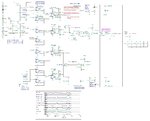d123
Advanced Member level 5

Hi,
I'd like to lump several questions into one thread if possible, please.
How might changing a circuit from a 12V supply to a 3V supply affect circuit performance, if at all? Can a lower supply be detrimental to comparator response regarding chatter that wasn't present on the 12V version?
On 12V and on 3V circuits, components are correctly selected.
Why would a 12.6V, 0.5 Ohm supply droop with a 1.6 A load? Nothing on the circuit is drawing the other 22.4 that should be available, BJT draws 10mA or 20mA to drive pass devices.
Why would the UVLO comparator chatter and only work correctly with the unwanted 220nF capacitor at the input?
I tried raising UVLO ref from ~254mV to 1V to extend resolution margins, dynamic hysteresis with varied capacitor values to replace Rfb (1.8M one), removed hysteresis, added OA buffer to lower input signal's source impedance, and in the end had to change input signal from lingering a few ms at 3V. Is LM193 too fast for this circuit: with its nominal ~1.3us rise and fall time with 5mV overdrive? Is a ~250mV ref not workable for some reason?
This circuit is being a headache only due to UVLO chatter at both rise and fall without the capacitor at the input to the OA buffer. I don't want an unreliable comparator circuit with slow-changing input signals. Any suggestions and/or observations, please?

UVLO is ~3V (254mV ref), OVLO is ~12.3V (1.00Vref).
- - - Updated - - -
...also lowered Rpull-up to 2.2k to speed up response but didn't help with PV UVLO chatter around 3V level.
I'd like to lump several questions into one thread if possible, please.
How might changing a circuit from a 12V supply to a 3V supply affect circuit performance, if at all? Can a lower supply be detrimental to comparator response regarding chatter that wasn't present on the 12V version?
On 12V and on 3V circuits, components are correctly selected.
Why would a 12.6V, 0.5 Ohm supply droop with a 1.6 A load? Nothing on the circuit is drawing the other 22.4 that should be available, BJT draws 10mA or 20mA to drive pass devices.
Why would the UVLO comparator chatter and only work correctly with the unwanted 220nF capacitor at the input?
I tried raising UVLO ref from ~254mV to 1V to extend resolution margins, dynamic hysteresis with varied capacitor values to replace Rfb (1.8M one), removed hysteresis, added OA buffer to lower input signal's source impedance, and in the end had to change input signal from lingering a few ms at 3V. Is LM193 too fast for this circuit: with its nominal ~1.3us rise and fall time with 5mV overdrive? Is a ~250mV ref not workable for some reason?
This circuit is being a headache only due to UVLO chatter at both rise and fall without the capacitor at the input to the OA buffer. I don't want an unreliable comparator circuit with slow-changing input signals. Any suggestions and/or observations, please?

UVLO is ~3V (254mV ref), OVLO is ~12.3V (1.00Vref).
- - - Updated - - -
...also lowered Rpull-up to 2.2k to speed up response but didn't help with PV UVLO chatter around 3V level.

